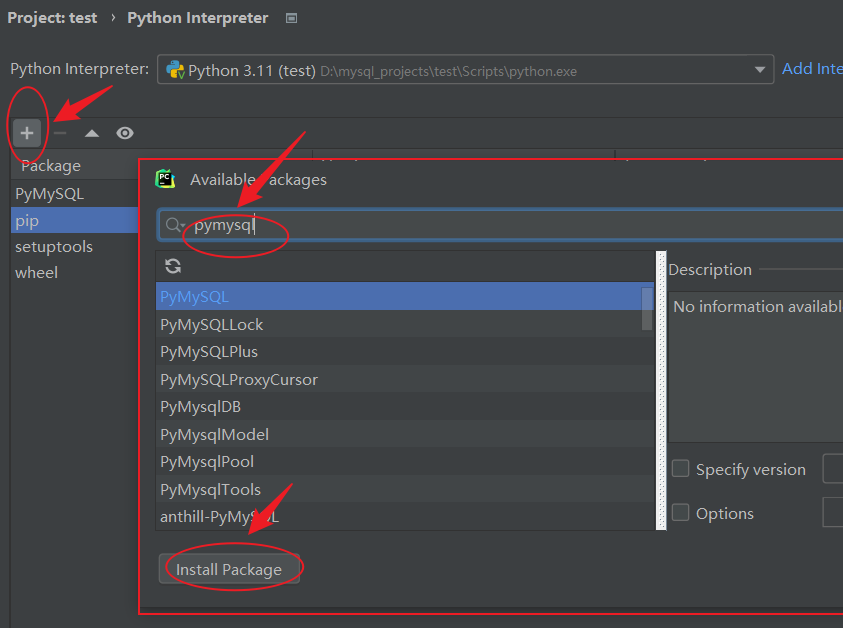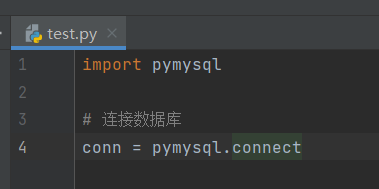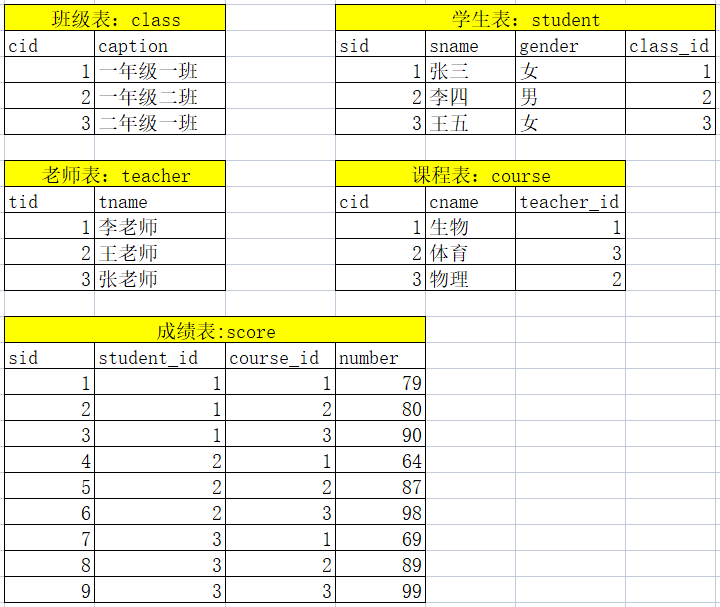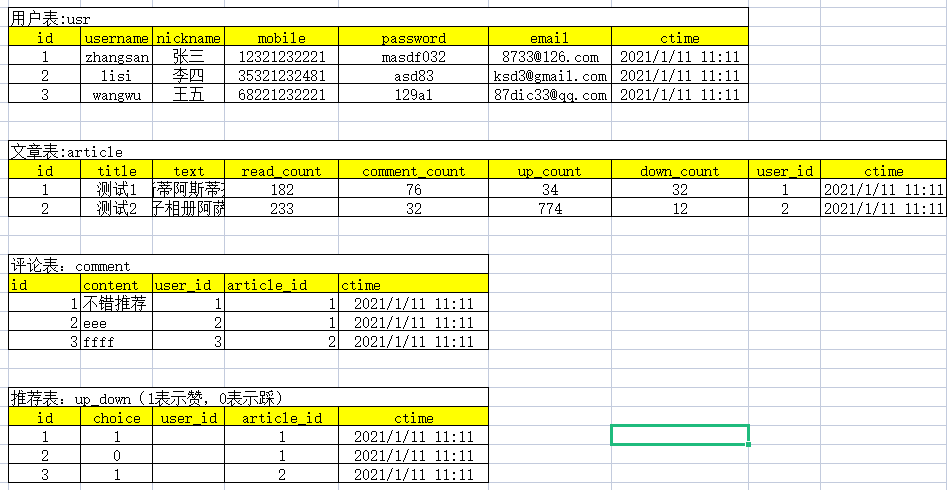1.下载安装Mysql
1.1 安装mysql57
下载Mysql5.7,暂不使用8.0版本:https://downloads.mysql.com/archives/community/
mysql-5.7.40-winx64.zip
解压到C:\Program Files\,这代表将mysql安装在这个位置
在C:\Program Files\mysql-5.7.40-winx64下新建:my.ini文件
[mysqld]
#端口
port=3306
#mysql的安装目录
basedir=C:\\Program Files\\mysql-5.7.40-winx64
#mysql的data目录
datadir=C:\\Program Files\\mysql-5.7.40-winx64\\data在终端中:
1,初始化mysql
"C:\Program Files\mysql-5.7.40-winx64\bin\mysqld.exe" --initialize-insecure
2,将mysql制作成windows服务
"C:\Program Files\mysql-5.7.40-winx64\bin\mysqld.exe" --install mysql57
3,启动mysql服务
net start mysql57
4,关闭mysql服务
net stop mysql57
1.2 测试mysql57
1,连接mysql:注意,这里使用的是mysql.exe而非mysqld.exe
"C:\Program Files\mysql-5.7.40-winx64\bin\mysql.exe" -h 127.0.0.1 -P 3306 -u root -p
2,默认是空密码,直接enter;
3,显示当前的数据库
show databases;

4,退出mysql
exit;
1.3 修改密码
1,设置密码:进入mysql后:
set password = password("123456")
则密码设置成功;
2,忘记密码:
1)在my.ini中增加一行:
skip-grant-tables=1
2)重启mysql,则可以不用密码登录
net stop mysql57
net start mysql57
3)进入mysql
"C:\Program Files\mysql-5.7.40-winx64\bin\mysql.exe" -h 127.0.0.1 -P 3306 -u root -p
3)按照步骤1设置密码;
4)删除my.ini中增加的skip-grant-tables=1
1.4 卸载mysql57
1,删除mysql57服务
"C:\Program Files\mysql-5.7.40-winx64\bin\mysqld.exe" --remove mysql57
2,删除mysql57目录
2. 安装配置pycharm
2.1 安装pycharm
略,参考相关教程
2.2 创建工程
略,参考相关教程
2.2 配置pycharm以使用PyMySQL
file -> settings -> project:xx -> python interpreter

即可新建python文件并使用PyMySQL了

3. MySQL基础
3.1 MySQL数据类型
int
int :有符号,取值范围:-2147483648 ~ -2147483647
int unsigned: 无符号取值范围0~ 4294967295
int(5)zerofill:很少使用,仅用于显示
tinyint
使用方法与int一样,但数据范围为-128~127,0~255
bigint
使用方法与int一样,但数据范围为-9223372036854775808~9223372036854775807,0~1844674407379551615
decimal [m[,d]] [unsigned] [zerofill]
m:数字总数(符号不算),最大值65
d:小数点后个数,最大值30
decimal(8,2):数字总体为8位,小数点后保留2位,小数超出时会4舍5入,整数位超出时会报错
float [m[,d]] [unsigned] [zerofill]
单精度浮点数,非精准小数,不常用
double [m[,d]] [unsigned] [zerofill]
双精度浮点数,非精准小数值,不常用
char(m)
定长字符,m代表字符串长度,最多配置位255个字符,字符不够时补充空格为m个字符,字符超出时会报错
varchar(m)
变长字符,m代表字符串长度,最多容纳65535个字符,字符不够时按照真实长度存储,字符超出时会报错
text
保存变长大字符串,一般用于文章或新闻,最长可到65535(2**16-1)个字符
mediumtext
最长可到16777215(2**24-1)个字符
longtext
最长可到4GB(2**32-1)个字符
datetime
YYYY-MM-DD:HH:MM:SS(1000-01-01 00:00:00 / 9999-12-31 23:59:59)
客户端存入的时间时不作改变,原样输入和输出。常用。
timestamp
YYYY-MM-DD:HH:MM:SS(1970-01-01 00:00:00 / 2037)
客户端存入的时间时,从当前时区转化为UTC(世界标准时间)进行存储,查询时有将其转化为客户端当前时区进行返回。不常用。
date
YYYY-MM-DD(1000-01-01 / 9999-12-31)
time
HH:MM:SS(-838:59:59 / 838:59:59)
3.2 表的关系
单表:单独一张保存信息的
一对多:两张表存储信息,且两张表存在一对多或多对一的关系
多对多:需要三张表来存储信息,两张表 + 关系表,创造出两个单表之间多对多关系
为建立表的关系,需要使用外键来建立约束
4. 使用PyMySQL操作数据库
4.1 连接数据库connect()
import pymysql
# 连接数据库
conn = pymysql.connect(host='127.0.0.1',port=3306,user='root',charset='utf8',password="123456")
cursor = conn.cursor()4.2创建数据库和表
#1.创建数据库,charset编码规则,collate排序规则
cursor.execute("create database db1 default charset utf8 collate utf8_general_ci")
#查询不需要commit(),增删改需要commit()
conn.commit()
#2.进入数据库创建表,并查看
cursor.execute("use db1")
sq1 = """
create table L1(
id int not null primary key auto_increment,
title varchar(128),
content text,
ctime datetime
)default charset=utf8;
"""
cursor.execute(sq1)
conn.commit()4.2-补1:创建数据表时的关键字
create table L1(
id int primary key auto_increment, --primary key主键,不允许为空,不能重复
--auto_increment自增
--一张表只能有一个主键,一个自增列,自增列一般为主键
name varchar(16) not null. --不允许为空
email varchar(32) null, --允许为空
age int default 3 --默认值为3
)default charset=utf8;4.2-补2:关联表时的外键
1,外键是一种索引,是通过一张表中的一列指向另一张表的 主键,使得这两张表产生关联
2,外键可以在创建表时添加,也可以后续使用alter table 表名 add constraint ......来添加;
3,外键也可通过alter table 表名 drop foreign key ....来删除
4,有多张表时,关系表需要有多个外键约束
参考: MySQL外键(详解)
参考: sql_外键
4.3 查看数据库和表,以及表的内容
# 查看数据库
cursor.execute("show databases")
result = cursor.fetchall()
print(result)
#进入数据库,查看数据表
cursor.execute("use db1")
cursor.execute("show tables")
result = cursor.fetchall()
print(result)
#查看数据表的内容
cursor.execute("desc l1")
result = cursor.fetchall()
print("desc:",result)
#查看数据表的数据
cursor.execute("select * from l1")
result = cursor.fetchall()
print("select:",result)4.4删除数据库和表,清空表
#删除数据库
cursor.execute("drop database db1")
conn.commit()
#删除数据表
cursor.execute("use db1")
cursor.execute("drop table l1")
conn.commit()
#清空数据表
cursor.execute("delete from l1")
或:
cursor.execute("truncate table l1") --速度快,但无法回滚和撤销4.5修改表
添加列
alter table 表名 add 列名 类型 [其他关键字];
删除列
alter table 表名 drop column 列名 类型;
修改类的类型
alter table 表名 modify column 列名 类型;
修改列名和类型
alter table 表名 change 原列名 新列名 新类型;
修改列默认值
alter table 表名 alter 列名 set default 默认值;
删除列默认值
alter table 表名 alter 列名 drop default;
4.6 数据行增删改查
新增数据:
insert into 表名 (列名,列名,...,列名) values(值,值,...,值)
insert into 表名 (列名,列名,...,列名) values(值,值,...,值),(值,值,...,值) --插入多行数据
insert into 表名 values(值,值,值),(值,值,值) --如果插入值的个数和列的个数相同,则可以不写列名删除数据
delete from 表名 --删除表里的所有数据
delete from 表名 where 条件 --按条件删除
例1:delete from tb1 where name="sdd"
例2:delete from tb1 where name='sdf' and id='123'
例3:delete from tb1 where name='sdb' or id='123'
例4:delete from tb1 where id>9修改数据
update 表名 set 列名=值
update 表名 set 列名=值 where 条件
例1:update tb1 set name="sdd" where id='123' --修改id为123的行的name为sdd
例2:update tb1 set age=age+1 where id='123' --修改id为123的行的age为原有值+1
例3:update tb1 set name=concat(name,"123") where id='123' --在id为123的行的name后加上123后缀查询数据
select * from 表名
select 列名,列名,列名 from 表名
select 列名,列名 as 别名 from 表名
select * from 表名 where 条件 --按条件搜索整张表
select 列名,列名 from 表名 where 条件 --按条件收索指定列例:
select * from tb1
select id,name from tb1
select id,name,111 from tb1 --表里面没有111时,查询结果会增加一列,其值全为111
select id,name,111 as age from tb1 --表里面没有111时,查询结果会增加一列,其值全为111,同时表头为age
select * from tb1 where id=1
select * from tb1 where id >1
select * from tb1 where id!=1
select * from tb1 where name="sdd" and password='123'4.7 where语句
条件查询: SQL语句之条件查询--WHERE(where)

4.8 排序order by
参考: SQL语句之排序查询--ORDER BY
4.9 取部分及分页查询limit
参考: SQL中limit的用法
参考: sql语句中的limit n,limit n,m 和 limit m offset n
4.10 聚合函数、分组group by及having
参考: sqlserver之group by 与over函数
参考: SQL之HAVING
参考: SQL中group by的用法总结
4.11 连表 join
参考: SQL连接表(内连接、左连接、右连接、交叉连接、全外连接
一般用左外连接,较少用右外连接
可以连接多张表
4.12 上下连表union
参考: SQL UNION运算符
union会去重,union all不去重
4.13 用户授权(权限管理)
用户和权限信息存储在mysql.user这张表中
查询用户和权限:SELECT user,authentication_string,host FROM mysql.user;
创建用户:create user username@ip indentified by '密码'
例如:
1)create user 'zhangsan'@'127.0.0.1' indentified by '123456' --在127.0.0.1这个ip地址上用zhangsan这个账户,用密码123456登录
2)create user 'zhangsan'@'%' indentified by '123456' --在任意ip地址上用zhangsan这个账户,用密码123456登录mysql
3)create user 'zhangsan'@'127.0.0.1' indentified by '123456' --在127.0.0.1这个ip地址上用zhangsan这个账户,用密码123456登录
删除用户:drop user 'zhangsan'@127.0.0.1
修改用户:rename user '张三'@'127.0.0.1' to 'lisi'@'128.3.12.2'
修改密码:set password for '张三'@'127.0.0.1' = password('738')
授权:grant 权限 on 数据库.表 to '用户'@'ip地址'
授权后刷新:FLUSH PRIVILEGES;
查看权限:show grants for '用户'@'ip地址'
取消授权:remoke 权限 on 数据库.表 from '用户'@'ip地址'
5. SQL数据库的导入/出
参考: Pycharm连接Mysql数据库操作、以Excel文件导入导出
6. 示例1:班级管理数据库操作
6.1 表结构

6.2 数据库操作
1创建数据库和表结构
--创建和使用数据库
create database db1 default charset utf8 collate utf8_general_ci;
use db1;
--创建表
create table class(
cid int not null auto_increasement primary key,
caption varchar(16) not null
)default charset=utf8;
--添加数据
insert into class values ('1','一年级一班'),('2','一年级二班'),('3','三年级一班')
......其余表(略)2创建用户并赋予权限
create user 'luffy'@'%' indentified by 'root123';
grant all privileges on db1.* to 'luffy'@'%';
flush privileges;3查询'李'姓老师名单
select * from teacher where tname like '李%'4查询男生、女生人数
select gender,count(1) from student group by gender;5查询同名同姓学生名单,并统计同名人数
select sname,count(1) from student group by sname having count(1)>1;6查询“三年级一班”的所有学生信息
select
*
from
student
left join class on student.class_id = class.cid
where class.caption='三年级一班';7查询每个班级的班级名称、班级人数
select
class.caption,count(1)
from
student
left join class on student.class_id = calss.cid
group by class.caption;8查询成绩小于60分的同学的学号、姓名、成绩、课程名称
select
student.sid,
student.sname,
score.number,
course.cname
from
score
left join student on score.student_id=student.sid
left join cource on score.course_id=course.cid
where number<60;9查询选修了“生物课”的所有学生ID、学生姓名、成绩
select
student.sid,
student.sname,
score.number
from
score
left join student on score.student_id=student.sid
left join course on score.course_id=course.cid
where
course.cname='生物';10查询选修了“生物课”且成绩低于60分的所有学生ID、学生姓名、成绩
select
student.sid,
student.sname,
score.number
from
score
left join student on score.student_id=student.sid
left join course on score.course_id=course.cid
where
course.cname='生物' and score.number<60;11查询所有同学的学号、姓名、选课数、总成绩
select
student_id,
student.sname,
count(1),
sum(number)
from
score
left join student on score.student_id=student.sid
group by student_id;12查询各科选修学生的人数
select
coourse_id,
course.cname,
count(1)
from
score
left join course on course.cid=score.course_id
group by course_id;13查询各科成绩的总分、最高分、最低分,显示:课程ID、课程名称、总分、最高分、最低分
select
course_id,
course.cname,
sum(number),
max(number),
min(number)
from
score
left join course on score.course_id=course.cid
group by course_id;14查询各科成绩的平均分,显示:课程id、课程名称、课程平均分
select
course_id,
course.cname,
avg(num)
from
score
left join course on score.course_id=course.cid
group by course_id;15查询各科成绩的平均分,显示:课程id、课程名称、课程平均分(按照从大到小排队)
select
course_id,
course.cname,
avg(num) as A
from
score
left join course on score.course_id=course.cid
group by course_id
order by A desc;16 查询各科成绩 平均分和及格率,显示:课程id、课程名称、平均分、及格率
select
course_id,
course.cname,
avg(num),
sum(case when score.num>60 then 1 else 0 end)/count(1)*100 as percent
from
score
left join course on score.course_id=course.cid
group by course_id17查询平均成绩大于60的所有学生的学号,平均成绩
select
student_id,
avg(number)
from
score
group by
student_id having avg(num)>6018查询平均成绩大于85的所有学生的学号、平均成绩、姓名
select
student_id,
student.sname,
avg(number)
from
score
left join student on score.student_id=student.sid
group by
student_id having avg(number)>=8519 查询“二年级一班”每个学生的学号、姓名、总成绩、平均成绩
select
student_id,
student.sname,
sum(number),
avg(number)
from
score
left join student on score.student_id=student.sid
left join class on student.class_id=class.cid
where
class.caption='二年级一班'
group by
student_id20查询各个班级的班级名称、总成绩、平均成绩、及格率(按平均成绩从大到小排序)
select
class.caption,
sum(number),
avg(number) as av,
sum(case when score.num>60 then 1 else 0 end)/count(1)*100 as JG
from
score
left join student on score.student_id=student.sid
left join class on student.class_id=class.cid
group by
class.caption
order by
av desc21查询学过李老师课程的同学的学号和姓名
select
student_id,
student.sname
from
score
left join student on score.student_id=student.sid
left join course on score.course_id=course.cid
left join teacher on course.teacher_id=teacher.tid
where
teacher.tname='李老师'22查询没学过李老师课程的同学的学号和姓名
select * from student where sid not in(
select
student_id
from
score
left join student on score.student_id=student.sid
left join course on score.course_id=course.cid
left join teacher on course.teacher_id=teacher.tid
where
teacher.tname!='李老师'
)23查询选修李老师所授课程的学生中,成绩最高的学生姓名及成绩(不考虑并列)
select
student.sname,
number
from
score
left join student on score.student_id=student.sid
left join course on score.course_id=course.cid
left join teacher on course.teacher_id=teacher.tid
where
teacher.tname='李老师'
order by
score.number desc
limit 124查询选修李老师所授课程的学生中,成绩最高的学生姓名及成绩(考虑并列)
select
student.sname,
number
from
score
left join student on score.student_id=student.sid
left join course on score.course_id=course.cid
left join teacher on course.teacher_id=teacher.tid
where
teacher.tname='李老师'
and score.number={
select
max(number)
from
score
left join course on score.course_id=course.cid
left join teacher on course.teacher_id=teacher.tid
where
teacher.tname='李老师'
}25查询只选修了一门课的全部学生的学号、姓名
select
student_id,
student.sname
from
score
left join student on score.student_id=student.sid
group by
student_id
having
count(1)=126查询至少选修了2门课程的学生、学生姓名、选修课程数量
select
student_id,
student.sname,
count(1)
from
score
left join student on score.student_id=student.sid
group by
student_id
having
count(1)>=227查询两门及以上不及格的同学的学号、姓名、选修课数量
select
student_id,
student.sname,
count(1)
from
score
left join student on score.student_id=student.sid
where
number<60
group by
student_id
having
count(1)>=228查询选修了所有课程的学生的学号、姓名
select
student_id,
student.sname
from
score
left join student on score.student_id=student.sid
group by
student_id
having
count(1) = (select count(1) from course)29查询未选修所有课程的学生的学号、姓名
select
student_id,
student.sname
from
score
left join student on score.student_id=student.sid
group by
student_id
having
count(1) < (select count(1) from course)30查询所有学生都选修了的课程的课程号和课程名
select
course_id,
course.cname
from
score
left join course on score.course_id=course.cid
group by
course_id
having
count(1) = ( select count(1) from student )31查询选修了生物和体育课程的所有学生的学号、姓名
select
student_id,
student.sname
from
score
left join student on score.student_id=student.sid
left join course on score.course_id=course.cid
where
course.cname in ("生物","体育")
group by
student_id
having
count(1)=232查询至少有一门与学号为“1”的学生所选修的课程相同的其他学生学号和姓名
select
student_id,
student.sname
from
score
left join student on score.student_id=student.sid
left join course on score.course_id=course.cid
where
score.student_id!=1 and
score.course_id in ( select course_id from score where student_id=1 )
group by
student_id
having
count(1)>=133查询与学号为2的同学选修的课程完全相同的其他学生学号和姓名
select
student_id,
student.sname
from
score
left join student on score.student_id=student.sid
left join course on score.course_id=course.cid
where
score.course_id in ( select course_id from score where student_id=1 )
and
--第二个条件为找到选修课程数量与学号为2的学生一样的id
score.student_id in(
select
student_id
from
score
where
student_id!=2
group by
student_id
having
count(1) = (select count(1) from score where student_id=2)
)
group by
student_id
having
count(1)=( select count(1) from score where student_id=2 )34查询生物课程比物理课程高的所有学生的学号和姓名
select
student_id,
student.sname,
max(case course.cname when '生物' num else -1 end) as sw,
max(case course.cname when '物理' num else -1 end) as wl
form
score
left join student on score.student_id=student.sid
left join course on score.course_id=course.cid
where
course.cname in ('生物','物理')
group by
student_id
having
sw > wl 35查询每门课程成绩最好的前3名(不考虑成绩并列)
select
cid,
cname,
--第一名
(select
student.sname
from
score
left join student on score.student_id=student.sid
where
course_id = course.id
order by
number desc
limit
1
offset
0
) as '第一名',
--第二名
(select
student.sname
from
score
left join student on score.student_id=student.sid
where
course_id = course.id
order by
number desc
limit
1
offset
1
) as '第二名',
--第三名
(select
student.sname
from
score
left join student on score.student_id=student.sid
where
course_id = course.id
order by
number desc
limit
1
offset
2
) as '第三名'
from
course
36创建一张有外键的表sc,把score的所有数据都插入到sc中
create table 'sc'{
'sid' int not null auto_increment primary key,
'student_id' int not null,
'course_id' int not null,
'num' int not null,
constraint 'fk_sc_course' foreign key ('course_id') reference 'course'('cid'),
constraint 'fk_sc_student' foreign key ('student_id') reference 'student'('sid')
} default charset=utf8;
insert into sc select * from score;37 向sc中插入一些记录,1)没有上过课程id为2的课程的学生id,2)课程id为2,3)成绩为80
insert into sc (student_id, course_id, number)
select
sid,
2,
80
from
student
where
sid not in (
select
student_id
from
score
where
course_id=2
)38 向sc中插入一些记录,1)没上过id为2的课程的学生id,2)课程id为2,3)成绩为课程id为3的最高分
insert into sc (student_id,course_id,number)
select
sid,
2,
(select
max(num)
from
score
where
course_id=3
) as num
from
student
where
sid not in (
select
student_id
from
score
where
course_id=2
) 7.示例2: 博客系统与索引
7.1 表结构

7.2索引
常见索引:
1,主键索引:加速查找,不能为空,不能重复,(多列) 联合主键索引
create table 表名(
id int not null auto_increment,
name varchar(32) not null,
primary key(id) --主键索引
);
create table 表名(
id int not null auto_increment,
name varchar(32) not null,
primary key(id,name) --多列,联合主键(不常用)
);
alter table 表名 add primary key(列名); -- 表创建完成后添加主键索引
drop table 表名 drop primary key;2,唯一索引:加速查找,不能重复 ,允许最大1个空(多列)联合唯一索引
create table 表名(
id int not null auto_increment primary key,
name varchar(32) not null,
email varchar(64) not null,
unique ix_name(name)
);
create table 表名(
id int not null auto_increment primary key,
name varchar(32) not null,
email varchar(64) not null,
unique ix_name(name), --唯一索引,每一列的内容不能重复
unique ix_emai(email) --多个唯一索引
);
create table 表名(
id int not null auto_increment primary key,
name varchar(32) not null,
email varchar(64) not null,
unique ix_group1(name,email) --多列,联合唯一索引,多列的内容,可以有一部分重复,但不能完全重复
);
create unique index 索引名 on 表名(列名);
drop unique index 索引名 on 表名3,普通索引:加速查找 (多列)联合索引
create table 表名(
id int not null auto_increment primary key,
name varchar(32) not null,
email varchar(64) not null,
index ix_name(name)
);
create table 表名(
id int not null auto_increment primary key,
name varchar(32) not null,
email varchar(64) not null,
index ix_name(name), --索引
index ix_emai(email) --多个索引
);
create table 表名(
id int not null auto_increment primary key,
name varchar(32) not null,
email varchar(64) not null,
index ix_group1 (name,email) --多列,联合索引
);
create index 索引名 on 表名(列名);
drop index 索引名 on 表名7.3索引不命中的情况
1,类型不一致
select * from tb1 where name=123 --未命中,效率低,因为表中name为字符串型
但主键索引类型不一致时不影响效率2,使用不等于
select * from tb1 where name!='123' --未命中,效率低,因为使用了不等于
但主键索引使用不等于时不影响效率3,or,当or条件中与未建立索引的列
select * from tb1 where name!='123' or password="xsd" --如果password未建立索引,则效率低4,排序,根据索引排序时,选择的映射如果不是索引,则不走索引
select * from tb1 order by name --即使name建立了索引,也无法命中,因为选择的是*
但使用主键order by时不受影响5,like,模糊匹配时通配符在前面或中间
select * from tb1 where name like '%uuu' --未命中
select * from tb1 where name like '__uuu' --未命中
select * from tb1 where name like 'u%-_uu' --未命中
select * from tb1 where name like 'uuu%' --命中
select * from tb1 where name like 'uuu_' --命中6,使用mysql内置函数时
select * from tb1 where reverse(name)='asdlf' --未命中
但对条件使用内置函数时命中
select * from tb1 where name=reverse('asdfj') --命中7,联合索引,应遵循最左前缀
如果联合索引为(name,password)
select * from tb1 where name='122' and password='233' --命中
select * from tb1 where name='122' --命中
select * from tb1 where password='233' --未命中
select * from tb1 where name='122' or password='233' --未命中7.4 索引 执行计划
在查询语句前,加explain,查看返回数据的type列。如果结果是all,则查询速度最低;如果结果是system/const,则查询速度最快;排序为all<index<range<index_merge<ref_or_null<ref<eq_ref<system/const
7.5博客系统 表索引 设计

对于推荐表:
1)id为主键索引;
2)user_id和article_id可以设计为联合唯一索引,因为用户只能评价一篇文章一次。

对于用户表:
1)id为主键索引;
2)用户名+密码,设计为联合索引,加快搜索进度;
3)手机号:唯一索引,因为不能重复;
4)邮箱:唯一索引,不能重复。
8.示例3:MySQL函数
8.1 内置函数
count()
max()
min()
avg()
reverse()
concat()
now()--获取当前时间
date_format(now(),'%Y-%m-%d %H:%m:%s')--按格式格式化时间
sleep(1)--等待1s
......8.2 自定义MySQL函数(一般不用)
--定义函数
delimiter $$
create function f1(
i1 int,
i1 int)
returns int
begin
declare num int;
declare maxID int;
select max(id) from tb1 into maxID;
set num = i1 + i2 +maxID;
return(num);
end $$
delimiter;
--调用函数
select f1(11,22);
select f1(11,id),name from tb1;
--删除函数
drop function f1;8.3 存储过程(不常用)
将一系列SQL语句集合存储在数据库中,当主动去调用存储过程时,其中内部的SQL语句会按照逻辑执行。
相比与使用python执行SQL,可以节约数据传输的时间,但是修改存储过程比较麻烦。
扫描二维码关注公众号,回复:
17336888 查看本文章


(更新中......)
附1:MySQL时区设置
时区
set time_zone='+0:00':设置时区为0区
show variables like '%time_zone%':查询时区
附2:SQL注入
基于字符串格式化来拼接SQL语句,存在SQL注入风险,如下面代码所示:
例如用户输入user为‘ or 1=1 -- 输入pwd为123,
则下述sql为select * from db1 where name='' or 1=1 -- and password='{}'
--后的被认为是注释,则where条件为1==1就是True,则实际上用户名不需要正确,也不需要密码,也能登录
cursor.execute("use db1")
user = input("请输入用户名")
pwd = input("请输入密码")
sql = "select * from db1 where name='{}' and password='{}'".format(user,pwd)
cursor.excute(sql)
result = cursor.fetchall()
print(result)为避免SQL注入问题,涉及到用户输入,应避免用传统的字符串格式化,应该用pymysql提供的方法
这种方法会帮助检测输入是否非法,且会帮助转义
cursor.execute("select * from db1 where name=%s and password=%s",[user,pwd])
#或者
cursor.execute("select * from db1 where name=%(n1)s and password=%(n2)s",{"n1":user,"n2":pwd})附3:sql执行顺序
join
on
where
group by
having
order by
limit